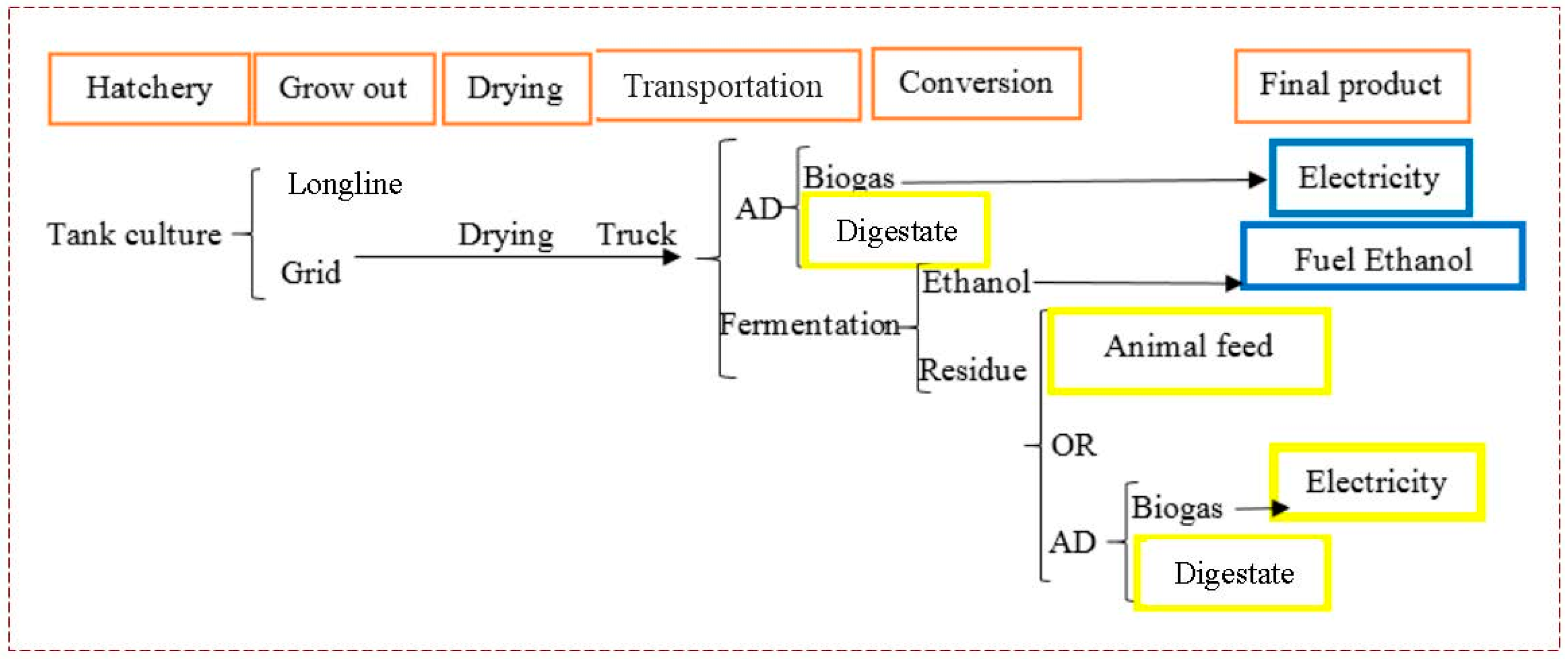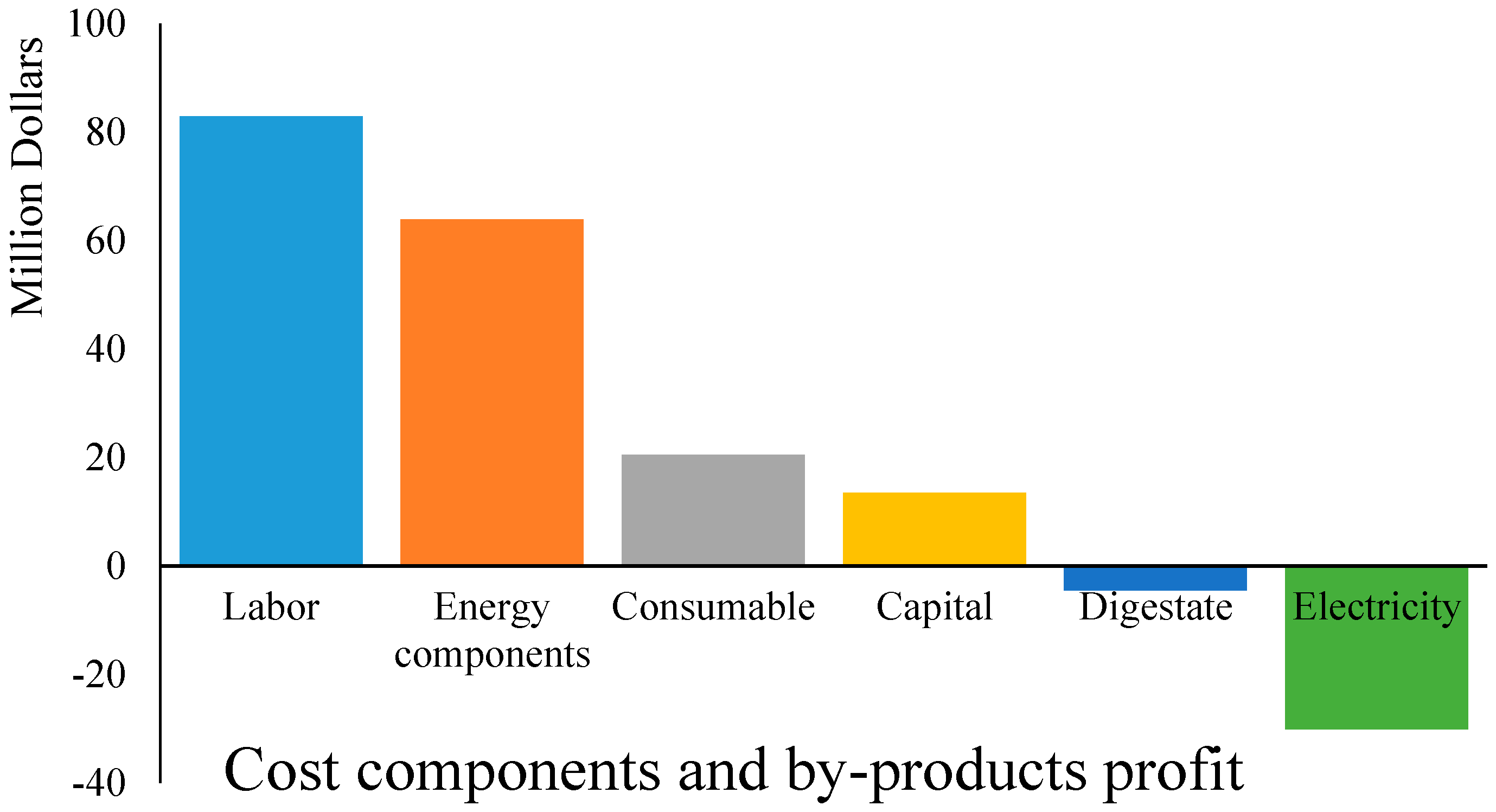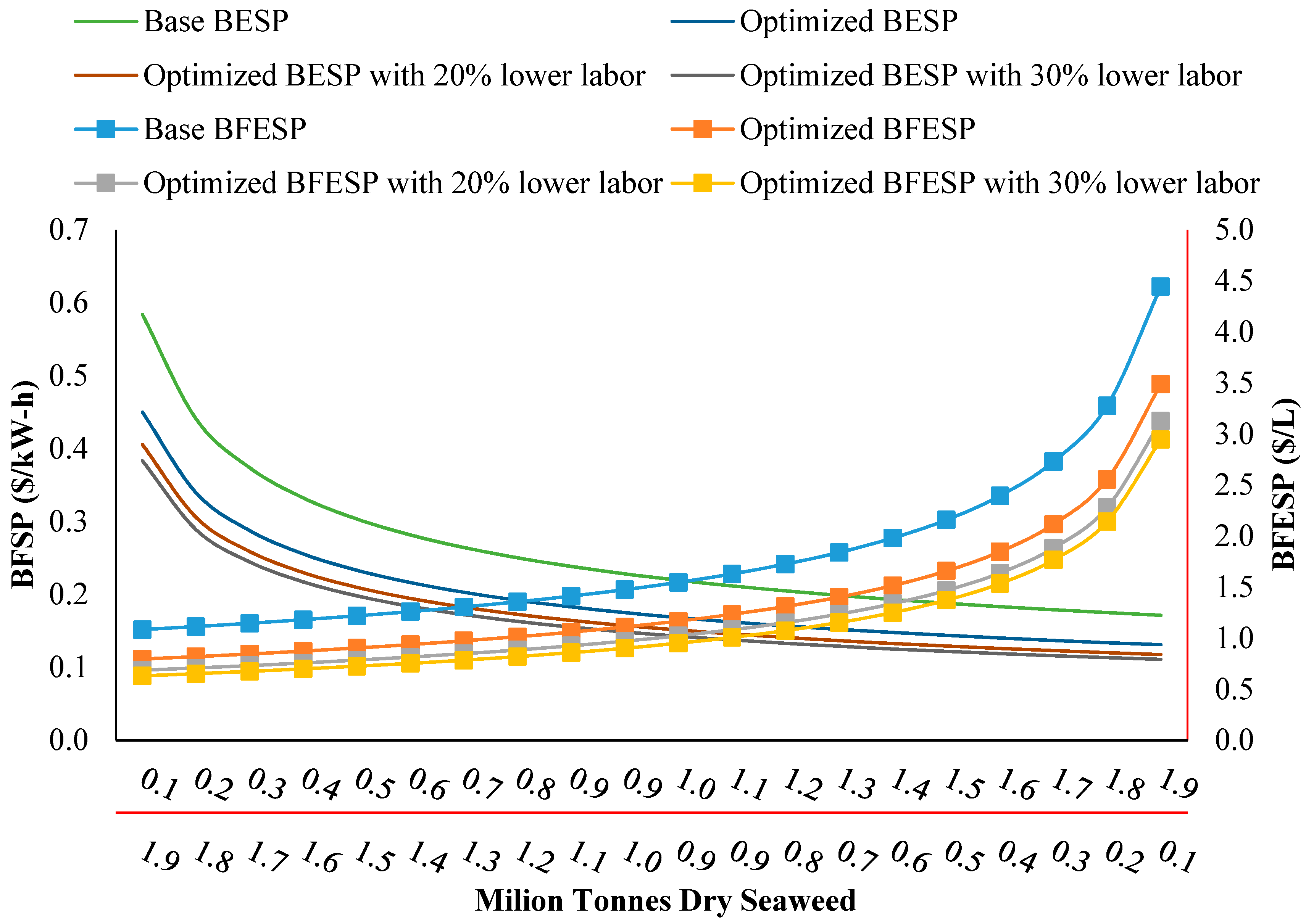Techno-Economic Analysis of Biofuel Production from Macroalgae (Seaweed)
Abstract
:1. Introduction
2. Methods
2.1. Data Sources, Calculation Methods, Scenarios, and Cost Analysis
2.2. Hatchery and Grow out Systems
2.3. Drying Systems
2.4. Transportation Systems
2.5. Conversion Systems
- AD (anaerobic digestion) integrated with the CHP system: Biogas produced in an AD is burned in a CHP system to produce electricity. The waste product (digestate) from AD was used as fertilizer.
- Ethanol production through fermentation: Ethanol is the main product in this method, and fermentation by-products are used as animal feed, digestate, or electricity production, based on the selected process method. Fermentation residuals can be converted into animal feed or can be digested to produce biogas and thus electricity. Specifically, the by-products in this method were animal feed or electricity and digestate as bio fertilizer, or the combination of these three products. According to [5], the rate of animal feed per liter of ethanol production is 1.21 kg. The amount of digestate production in residual fermentation followed by AD was equal to the amount of fresh seaweed fermentation in AD, but electricity production was reduced to 64% compared to scenario 1 (based on [10]).
2.5.1. Fermentation
2.5.2. Anaerobic Digestion (AD)
2.6. Techno-Economic Analysis
3. Results and Discussion
3.1. Breakeven Price
3.2. Economic Analysis of the Production (Supply) Chain
- Establish processing facilities and equipment in the closest location to the beach/water as possible; this will minimize the cost of transportation. Also, some of the seaweed can be consumed in fresh form in AD or fermentation (i.e., during the harvest season) without the need to dry and store the seaweed. Taking into account no transportation between the shoreline and the conversion equipment, and use of 25% of fresh seaweed, the BFESP and BESP can be reduced to approximately 1.17 ($/L) and 0.23 ($/kW-h), respectively.
- Reduce production costs. As shown in Figure 2, the most dominant costs in the production chain are labor and energy inputs. So, with better management of cost components, the BESP and BFESP can be reduced. Considering the previous suggestion (establishment of integrated facilities near the shore) and by decreasing the labor cost by 20 and 30 percent, the BFESP can be decreased to 1.02 and 0.95 ($/L), respectively, and also BESP can be reduced to 0.16 ($/kW-h) and 0.15 ($/kW-h), respectively.
- Increase productivity per unit area. The seaweed production yield in this study was only 5.25 and 2.7 (dry t/ha), respectively, for longline and grid farms; however, the average global yield of seaweed can range from 12 to 60 (dry t/ha) [17].
- Extend the production scale. As shown in Figure 3, by increasing the production scale, costs can be pro-rated, and BESP and BFESP will be decreased.
3.3. Effect of Scale on Overall Cost
4. Conclusions
Author Contributions
Conflicts of Interest
References
- US EPA. Global Greenhouse Gas Emissions Data. 2013. Available online: http://www.epa.gov/climatechange/ghgemissions/global.html (accessed on 25 November 2017).
- Dragone, G.; Fernandes, B.D.; Vicente, A.A.; Teixeira, J.A. Third Generation Biofuels from Microalgae. 2010. Available online: http://www.formatex.info/microbiology2/1355-1366.pdf (accessed on 25 November 2017).
- Jung, K.A.; Lim, S.R.; Kim, Y.; Park, J.M. Potentials of macroalgae as feedstocks for biorefinery. Bioresour. Technol. 2013, 135, 182–190. [Google Scholar] [CrossRef] [PubMed]
- Alvarado-Morales, M.; Boldrin, A.; Karakashev, D.B.; Holdt, S.L.; Angelidaki, I.; Astrup, T. Life cycle assessment of biofuel production from brown seaweed in Nordic conditions. Bioresour. Technol. 2013, 129, 92–99. [Google Scholar] [CrossRef] [PubMed]
- Philippsen, A. Energy Input, Carbon Intensity, and Cost for Ethanol Produced from Brown Seaweed. Ph.D. Thesis, University of Victoria, Victoria, BC, Canada, 2013. [Google Scholar]
- Bringezu, S.; Ramesohl, S.; Arnold, K.; Fischedick, M.; von Geibler, J. Towards a Sustainable Biomass Strategy: What We Know and What We Should Know; Wuppertal Papers: Wuppertal, Germany, 2007. [Google Scholar]
- Eisentraut, A. Sustainable Production of Second-Generation Biofuels: Potential and Perspectives in Major Economies and Developing Countries; IEA Energy Papers, No. 2010/01; OECD Publishing: Paris, France, 2010. [Google Scholar]
- Roesijadi, G.; Jones, S.B.; Snowden-Swan, L.J.; Zhu, Y. Macroalgae as a Biomass Feedstock: A Preliminary Analysis; PNNL 19944; Pacific Northwest National Laboratory: Richland, WA, USA, 2010. [Google Scholar]
- Ross, A.B.; Jones, J.M.; Kubacki, M.L.; Bridgeman, T. Classification of macroalgae as fuel and its thermochemical behaviour. Bioresour. Technol. 2008, 99, 6494–6504. [Google Scholar] [CrossRef] [PubMed]
- Dave, A.; Huang, Y.; Rezvani, S.; McIlveen-Wright, D.; Novaes, M.; Hewitt, N. Techno-economic assessment of biofuel development by anaerobic digestion of European marine cold-water seaweeds. Bioresour. Technol. 2013, 135, 120–127. [Google Scholar] [CrossRef] [PubMed]
- Borines, M.G.; De Leon, R.L.; McHenry, M.P. Bioethanol production from farming non-food macroalgae in Pacific island nations: Chemical constituents, bioethanol yields, and prospective species in the Philippines. Renew. Sustain. Energy Rev. 2011, 15, 4432–4435. [Google Scholar] [CrossRef]
- Mabeau, S.; Fleurence, J. Seaweed in food products: Biochemical and nutritional aspects. Trends Food Sci. Technol. 1993, 4, 103–107. [Google Scholar] [CrossRef]
- Smit, A.J. Medicinal and pharmaceutical uses of seaweed natural products: A review. J. Appl. Phycol. 2004, 16, 245–262. [Google Scholar] [CrossRef]
- Burton, T.; Lyons, H.; Lerat, Y.; Stanley, M.; Rasmussen, M.B. A Review of the Potential of Marine algae as a Source of Biofuel in Ireland; Sustainable Energy Ireland-SEI: Dublin, Ireland, 2009. [Google Scholar]
- Edwards, M.; Watson, L. Cultivating Laminaria digitata. In Aquaculture Explained; Bord Iascaigh Mhara (BIM): Dún Laoghaire, Ireland, 2011; Volume 26, pp. 1–71. [Google Scholar]
- Aizawa, M.; Asaoka, K.; Atsumi, M.; Sakou, T. Seaweed Bioethanol Production in Japan-The Ocean Sunrise Project. In Proceedings of the OCEANS 2007, Vancouver, BC, Canada, 29 September–4 October 2007; IEEE: Piscatawaym, NJ, USA, 2007; pp. 1–5. [Google Scholar]
- Oilgae. Oilgae Guide to Fuels from Macroalgae; Oilgae: Tamilnadu, India, 2010. [Google Scholar]
- Valderrama, D. Social and Economic Dimensions of Seaweed Farming: A Global Review. 2012. Available online: http://hdl.handle.net/1957/33886 (accessed on 25 November 2017).
- Watson, L.; Dring, M. Business Plan for the Establishment of a Seaweed Hatchery and Grow-Out Farm; Irish Sea Fisheries Board: Dun Laoghaire, Ireland, 2011. [Google Scholar]
- The U.S. Energy Information Administration. Short Term Energy Outlook; US Energy Information Administration: Washington, DC, USA, 2013.
- Van den Burg, S.W.K.; van Duijn, A.P.; Bartelings, H.; van Krimpen, M.M.; Poelman, M. The economic feasibility of seaweed production in the North Sea. Aquac. Econ. Manag. 2016, 20, 235–252. [Google Scholar] [CrossRef]
- Nayar, S.; Froese, F. Are biofuels from seaweed a viable proposition? Bioeconomic modeling of biogas production and co-generation in an Australian context. Biofuels 2013, 4, 371–378. [Google Scholar] [CrossRef]
- Konda, N.V.S.N.; Singh, S.; Simmons, B.A.; Klein-Marcuschamer, D. An investigation on the economic feasibility of macroalgae as a potential feedstock for biorefineries. BioEnergy Res. 2015, 8, 1046–1056. [Google Scholar] [CrossRef]
- Stephens, E.; Ross, I.L.; King, Z.; Mussgnug, J.H.; Kruse, O.; Posten, C.; Borowitzka, M.A.; Hankamer, B. An economic and technical evaluation of microalgal biofuels. Nat. Biotechnol. 2010, 28, 126–128. [Google Scholar] [CrossRef] [PubMed]
- McAloon, A.; Taylor, F.; Yee, W.; Ibsen, K.; Wooley, R. Determining the Cost of Producing Ethanol from Corn Starch and Lignocellulosic Feedstocks; National Renewable Energy Laboratory Report: Golden, CO, USA, 2000. [Google Scholar]
- Yarish, C.; Pereira, R. Mass Production of Marine Macroalgae. In Encyclopedia of Ecology; Jørgensen, S.E., Fath, B.D., Eds.; Elsevier: Amsterdam, The Netherlands, 2008; Volume 3, pp. 2236–2247. [Google Scholar]
- USDA. Grain Transportation Quarterly Updates. 2012. Available online: https://www.ams.usda.gov/services/transportation-analysis/gtr (accessed on 25 November 2017).
- Horn, S.J.; Aasen, I.M.; Østgaard, K. Production of ethanol from mannitol by Zymobacter palmae. J. Ind. Microbiol. Biotechnol. 2000, 24, 51–57. [Google Scholar] [CrossRef]
- Kim, N.J.; Li, H.; Jung, K.; Chang, H.N.; Lee, P.C. Ethanol production from marine algal hydrolysates using Escherichia coli KO11. Bioresour. Technol. 2011, 102, 7466–7469. [Google Scholar] [CrossRef] [PubMed]
- Yanagisawa, M.; Nakamura, K.; Ariga, O.; Nakasaki, K. Production of high concentrations of bioethanol from seaweeds that contain easily hydrolyzable polysaccharides. Process Biochem. 2011, 46, 2111–2116. [Google Scholar] [CrossRef]
- Chynoweth, D.P.; Owens, J.M.; Legrand, R. Renewable methane from anaerobic digestion of biomass. Renew. Energy 2001, 22, 1–8. [Google Scholar] [CrossRef]
- The U.S. Energy Information Administration. Levelized Cost of New Generation Resources in the Annual Energy Outlook 2011; US Energy Information Administration: Washington, DC, USA, 2013.



| Scenario | Farm Method | Conversion Method | By-Products | Final Product | Breakeven Selling Price of Final Product | |
|---|---|---|---|---|---|---|
| 1 | Longline | Fermentation | Animal feed | Ethanol | 1.87 ($/L) | |
| 2 | Grid | Fermentation | Animal feed | Ethanol | 1.93 ($/L) | |
| 3 * | Longline | Fermentation | Electricity | Digestate | Ethanol | 1.55 ($/L) |
| 4 | Grid | Fermentation | Electricity | Digestate | Ethanol | 1.61 ($/L) |
| 5 * | Longline | AD | Digestate | Electricity | 0.23 ($/kW-h) | |
| 6 | Grid | AD | Digestate | Electricity | 0.24 ($/kW-h) | |
| Percent of Residuals Used for Animal Food | 100 | 90 | 80 | 70 | 60 | 50 | 40 | 30 | 20 | 10 |
|---|---|---|---|---|---|---|---|---|---|---|
| BFESP ($/L) | 1.87 | 1.85 | 1.83 | 1.81 | 1.79 | 1.76 | 1.74 | 1.71 | 1.68 | 1.65 |
© 2017 by the authors. Licensee MDPI, Basel, Switzerland. This article is an open access article distributed under the terms and conditions of the Creative Commons Attribution (CC BY) license (http://creativecommons.org/licenses/by/4.0/).
Share and Cite
Soleymani, M.; Rosentrater, K.A. Techno-Economic Analysis of Biofuel Production from Macroalgae (Seaweed). Bioengineering 2017, 4, 92. https://doi.org/10.3390/bioengineering4040092
Soleymani M, Rosentrater KA. Techno-Economic Analysis of Biofuel Production from Macroalgae (Seaweed). Bioengineering. 2017; 4(4):92. https://doi.org/10.3390/bioengineering4040092
Chicago/Turabian StyleSoleymani, Mohsen, and Kurt A. Rosentrater. 2017. "Techno-Economic Analysis of Biofuel Production from Macroalgae (Seaweed)" Bioengineering 4, no. 4: 92. https://doi.org/10.3390/bioengineering4040092






